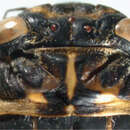Description
provided by Zookeys
Redescription: Male. General appearance of body black with yellowish and white pile.
Head. General color of head blackish yellow with white scattered pile. Vertex blackish with sparse pile and some specimens have yellowish area between ocelli and top of postclypeus surrounded by yellowish area. Eyes yellowish brown and rarely blackish. Ocelli reddish brown and rarely yellowish. Epicranial suture generally yellowish. Antennae blackish. Frons black with white pile. Postclypeus with a central sulcus obvious transverse grooves with long pile specifically located near gena and edge of mandibular plate, transverse grooves blackish. Gena brownish with white pile specifically below the antennae. Mandibular plate yellowish with white pile. Anteclypeus yellowish brown with blackish area dorsally and white pile on lateral edge. Rostrum almost reaches coxae III, yellowish brown at base, darker towards apex, rarely yellowish laterally and with sparse pile (Fig. 1-A).
Thorax. Pronotum blackish, wider than vertex and twice as long as it, pronotumwith three large patch divided by pronotal and lateral fissure in both half and both fissure with white scattered pile (Fig. 1-A). Both patches brownish black. Lateral angle of pronotal collar widened, ambient fissure nearly smooth. Mesonotum narrowed posteriorly like a bow and blackish with M-shaped yellowish fasciae. Sometimes U-shaped on parapsaidal sutures and nearly cover mesonotum. Lateral part of mesonatal collar and metanotum yellowish with short piles, scutal depression spoonlike and blackish, scutellum yellowish and blackish on both side (Fig. 1-B).
Legs. Fore coxae rectangle-shaped, with mid-cavity, yellowish with pile and black band basally. Middle and hind coxae trapezoid-shaped, shiny yellowish with pile and middle coxae with a black band basally, hind coxae with half depression in the middle. Fore, middle, and hind trochanters yellowish with dark brown basally, with piles at both corners, sometimes hind trochanters only yellowish. Fore femorae dark brown with white piles and yellow areas on lateral edges, sometimes areas irregular. Slightly angled primary spine, erect secondary spine and nearly erect apical spine, spines and surrounding areas blackish. Middle femorae yellowish with one or two dark brown bands dorsally and white pile. Hind femorae yellowish with white pile and brownish band dorsally. Fore tibia blackish brown with dense pile especially ventrally. Middle tibia yellowish, with piles and varying one to two brownish bands. Hind tibia yellowish with piles and five brown tibial spurs and sparse white pile. Tibial spurs and combs brown, darker distally. Fore tarsi blackish, middle tarsi black-brownish and hind tarsi yellow-brownish. Claws brownish basally and darker distally.
Wings. Fore wings at rest roof shaped, covering the abdomen and hyaline with yellowish venation basally and venation apically, R+Sc veins blackish. Basal cell on fore wings heptagonal, cubitus anterior and median veins originate separately. Cubitus posterior and median veins closer at base. Cubitus posterior anal veins not combined at base or apex. Fore wings with 8 apical cells and CuA1 wider than other apical cells (Fig. 1-C). Hind wing hyaline with yellowish venation and with 6 apical cells.
Operculum. Opercula yellow generally with brown spot on lateral base and white pile, broadly rounded apically, approaching one another and meeting medially.
Abdomen. Abdominal tergites blackish with white pile more or less located near the anterior edge of each tergum. Generally tergites one to seven with a light area on posterior apical part. Timbal cavity exposed. Timbal cover incomplete, blackish or brownish yellow with white short pile dorsally. Timbal with 11 ribs (Fig. 12). Abdominal sternites yellowish. On sternite II blackish area and on sternite III blackish spot at the base in the middle. Epipleurites yellowish.
Pygofer.blackish brown dorsally, yellowish brown ventrally. Posteriorly bow-shaped and sparsely setae dorsa-laterally, smooth dorsally, ventral slightly wavy (Fig. 2). Dorsal beak higher than upper lobe of pygofer and acute. The aedeagus bipartite basally, extending apically in a pipe shape, at apex pointed appendages like lamellae (Fig. 3). Sternite VIII concave basally, widened in the middle and slightly narrows to apex (Fig. 4).
- license
- cc-by-3.0
- copyright
- Abbas Mol, Unal Zeybekoglu, Basak Akyurek
- bibliographic citation
- Mol A, Zeybekoglu U, Akyurek B (2013) Morphological and acoustic characters of Cicadatra platyptera Fieber, 1876 ZooKeys 296: 1–23
- author
- Abbas Mol
- author
- Unal Zeybekoglu
- author
- Basak Akyurek
Distribution
provided by Zookeys
Europe, North Africa, Russia, Turkey, Iran, Israel, Lebanon, Syria (Dlabola 1974, Lodos and Kalkandelen 1981, Ahmed and Sanborn 2010).
- license
- cc-by-3.0
- copyright
- Abbas Mol, Unal Zeybekoglu, Basak Akyurek
- bibliographic citation
- Mol A, Zeybekoglu U, Akyurek B (2013) Morphological and acoustic characters of Cicadatra platyptera Fieber, 1876 ZooKeys 296: 1–23
- author
- Abbas Mol
- author
- Unal Zeybekoglu
- author
- Basak Akyurek

